More Guitar Amps
Soaring leads, monstrous rhythms – a distorted guitar output lies at the very core of heavy metal music. High gains with heave metal amps are an absolute must in this music genre, along with technical skills, chops, and mastery of the guitar. A reliable amp is almost as important as the guitar itself – from the glorious 80s hair metal days to modern metal chug-rhythms.
Metal is a diverse genre, and the proper amp must be able to fulfill your sonic requirements. Classic metal distortion of the earlier years is different from high-gain extreme metal distortion. We realize that an expensive tube amp is leagues ahead of an amp meant for rehearsals or small intimate gigs. But, not everyone needs professional-grade instruments/equipment. The Fender Champion 40 is probably the most affordable and versatile amp available in the market. It offers amazing value-for-money and can be used for different musical genres, including metal. The Marshall DSL40CR is a combo tube amp similar to the Champion 40, made by legendary amp manufacturers Marshall. The Peavey Bandit 112 is more expensive than Fender Champion 40. It is also the overall better choice.
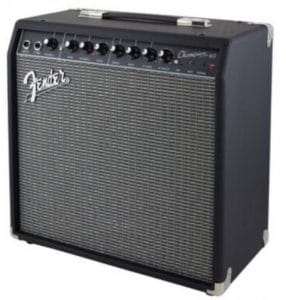
Best Heavy Metal Amps – Comparison Table
Table of Contents
| Image | Product | |
|---|---|---|
Versatile Workhorse Loaded with Features 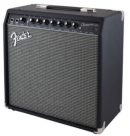 | Fender Champion 40
| Check Price |
Legendary British Distortion Ideal for Traditional Heavy Metal 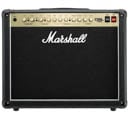
| Marshall DSL40C
| Check Price |
Solid-State Combo Amp with a Tube-Emulated Output 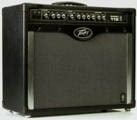
| Peavey Bandit 112
| Check Price |
Bone-Crushing Distorted Metal Tones 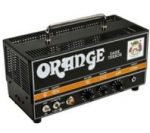 | Orange Dark Terror
| Check Price |
A Compact Signature Head Capable of Versatile Sonic Options 
| PRS Paul Reed Smith MT15
| Check Price |
A Metal Classic Designed by a Metal Virtuoso 
| EVH 5150 III 50W
| Check Price |
Powerful Distortion Focussed on Lows and Low-Mids 
| Randall EOD88
| Check Price |
Best choice headphone amp with various tones 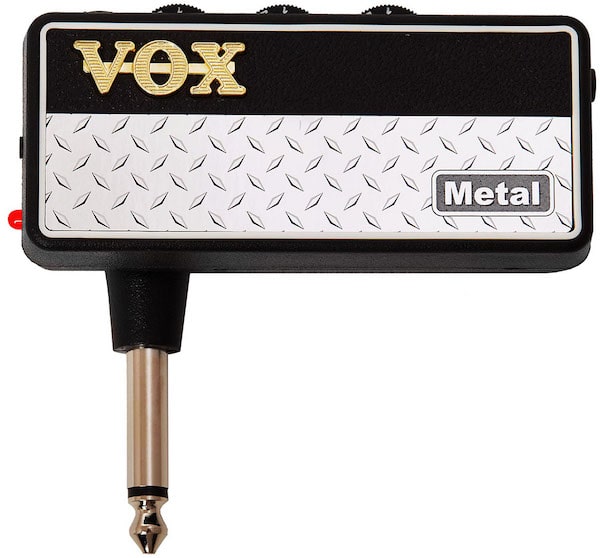
| Vox amPlug 2 AC30
| Check Price |
Fender Champion 40 – An Affordable Workhorse Loaded with a Wide Array of Features

Sound Performance
The solid-state combo showcases a change in the technology of the legendary Fender amps of yesteryears. For instance, the amp features lots of programmable onboard effects, along with the digital amp modeling.
The changes make the amp accessible in any music genre – from rock, blues, jazz, and metal. The output sound is also enough for band rehearsals or small intimate gigs.
Design Specifications:
Wattage and Type: 40 Watts. Solid-state – with digital amp modeling.
Input Channels: 1 input. Two channels.
Line Out: Aux input. Headphone out.
Weight: 19 lbs.
Pros
- Versatile amp at an affordable price range bearing the legendary Fender reliability.
- Multiple onboard effects, including delay, chorus, tremolo, reverb, vibratone.
- Digital amp modeling allows the player to choose from multiple amp models.
- Headphone out, aux-in for silent practice or jamming along to a track.
- 40 watts of solid-state power working through a 12” Fender Special Design speaker.
Cons
- Not suitable for large arenas/auditoriums.
- Reverb could have been a bit better.
- No Bluetooth, USB, or mobile connectivity.
- You can use footswitch with the amp, but it is not included.
- Good for beginners and intermediates, but not recommended for professional live/studio settings.
Recommended: Yes, a versatile option that makes it easy to craft out a signature tone.
To check the current price of Fender Champion 40, click here
Marshall DSL40CR – Compact Affordable Combo with the Famed Marshall Distortion
DSL40CR is the affordable variant of the legendary Marshall DSL100H packing most of the sonic character of its elder brother. The design is faithful to the typical Marshall design – black grilles, and black covering with a golden colored control section. The DSL40C is rugged and sturdy – built for the long run.
Sound Performance
The DSL40C bears the hallmark of a true Marshall – it sounds good both clean and in overdrive. The crunchy overdrive has a wide spectrum, while the ultra-gain channel is what you should look for in the case of relentless heavy metal distortion. The first lead mode is ideal for the 80s era glam metal. Lead 2 packs in more gain with a slight-mid boost.
Design Specifications
- Wattage and Type: 40 Watts. Tube combo.
- Input channels: 1 input. 2 split channels – Ultra Gain and Classic gain.
- Line Out: Aux input, Headphone out.
- Weight: 50.4 lbs.
Pros
- Versatile distorted output ideal for classic and traditional heavy metal.
- 40 watts power (can be reduced to 20 watts).
- Digital Reverb, effects loop send/return, 3-Band EQ, controls for Resonance and Presence.
- Tube Circuitry: 4xECC83 preamp valves and 2xEL34 valves.
- 1×12” Celestion V-type speaker.
- MIDI-in. Footswitch included.
Cons
- It is heavy amp for heavy metal
- You have a limited range of effects or modulation.
- Not suited for modern ultra high-gain metal tones.
- Speaker could have been better.
- Reverb is not the best available in the market.
Recommended: Yes, if you are not concerned about its weight.
To check the current price of Marshall DSL40CR, click here
Peavy Bandit 112 – Dual channel solid-state Transtube tube emulation circuitry that’s surprisingly accurate
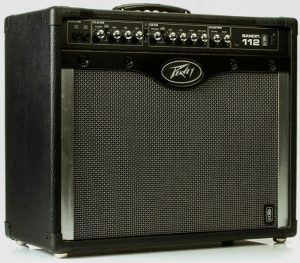
The Peavey Bandit 112 is a solid-state amplifier. It features a 12-inch speaker and has 80 watts of power, so it’s perfect for a gigging situation where you need a lot of power.
You can get a lot of different sounds out of the Bandit 112. You get a clean and a gain channel. Each one has its own EQ settings so you can sculpt your tone the way you like. EQ includes low, mid, and high controls.
There is both a high gain and a low gain input for your guitar, so you have different overdrive options to choose from. You also get a switch for classic/modern/and high gain settings for even more variety in the distortion settings.
There is a footswitch for any pedals that you own. The TransTube circuitry mimics the sound of a real tubes. You get an authentic tube-like tone out of the Peavey bandit 112. Other extras include a speak simulated direct output on the back. You can set the power level to 25, 50, and 100% for different playing situations.
Design Specifications
- 80 watts
- 40 lbs
- Two channels (lead and clean)
- 1 x 12 speaker
- Footswitch
- Low and high gain inputs
- Low, mid, and high EQ settings
- Speaker and speaker simulated outputs
- Reverb
- Effects loop
Pros
- Great distortion
- Effects loop
- Two gain inputs
Cons
- No effects except reverb
- A lot of power for a beginner
Whom is it Suited For?
It’s suited for anyone that wants solid overdrive and clean settings. The Bandit 112 is well-suited to a wide range of styles such as rock, metal, blues, and similar styles. It’s the ideal solution for anyone that wants to perform gigs thanks to the 80s watts of power.
The Peavey Bandit 112 is an excellent product for intermediate or advanced guitar layers that want a lot of power. The 80 watts will get you through most gigs in style. It has excellent distortion and a lot of settings for that distortion so you can get a tone that you like out of it. The bandit 112 is a recommended product for those that want tube-like tone out of a solid-state amplifier.
To check the current price of Peavey Bandit 112, click here
Orange Dark Terror – A tiny compact head that thrives at unapologetically high levels of gain and distortion
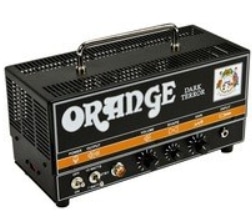
The Orange Dark Terror is a low-watt amp head, but don’t let its small size fool you. It has killer high-gain for many different styles of music. It’s the best use for hard rock and metal thanks to the gain channel. It’s powered by tubes, so you get a warm tone out of it even when cranked. It supplies 15 watts, but it is still quite loud and suitable for a smaller gig with some cabinets. Dark Terror has four stages of gain, and the preamp has a new tone circuit for more clarity out of it when playing. It has a decent clean channel, but really shine son the distorted end when you need more high gain, the Dark Terror delivers for you. There is also an effects loop to hook up your pedals if you wish.
Design Specifications:
- 15 watts
- 3 12AX7 preamp tubes, one 12AT7 for the effects loop, and 2 EL84 matched power valves
- Speaker output: 1×8 OHM OR 1×16 OHM OR 2×16 OHM
- Dimensions: 30.3 × 19 × 15.3CM (11.93 × 7.48 × 6.02″)
- Weight: 12.46lbs.
- Gain, shape, and volume knobs
- Effects loop
Pros
- Excellent high gain
- Superior tone circuit for better sound
- Lightweight and portable
Cons
- Not the best for larger gigs
What is it Suited For?
It’s suited for anyone that wants a high gain amp that sounds great when cranked. It’s suited for beginners, and intermediate players as the 15 watts are perfect for practice or a small gig. Professionals may want a little more as the 15 watts won’t cut it on larger stages.
The Orange Dark Terror is the best ones for heavy metal on our list. The reason we picked it is the superior distorted tone you get out of it. It has a rich high gain that can do basic rock right up to today’s screaming metal with no problems at all. If you want to play more aggressive styles, the Orange Dark Terror is the one you want to have.
To check the current price of Orange Dark Terror, click here
PRS MT15 Paul Reed Smith – a dual power classic head designed by Alter Bridge guitar extraordinaire – Mark Tremonti
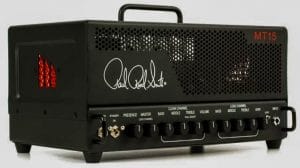
The head looks like a lunch box, so it’s compact and small but has a big sound. It has both 15 and 7 watts of power with two settings. It’s powered by tubes, so you get a great tube tone. The head works great with any 1 x 12 cabinet, but the PRS model works the best with this head. It has enough power to compete with larger 50-watt products due to the tube configuration.
You get great cleans and gain out of it, full EQ controls for the two channels, and you have the ability to switch channels with the footswitch.
The clean channel has boost, and the lead channel has a gain control. It’s also has a presence control that you won’t find on similar small amps. It has a high gain that is suitable for most hard rock and metal styles of music. You get nice levels of harmonics with the gain. You tun up the volume, you get more gain, which is never muddy. The clean tones are also excellent on the PRS MT15.
Design Specifications:
- 15 watts
- 2 channels
- Effects loop
- Preamp Tubes: 6 x JJ ECC83S
- Power Tubes: 2 x 6L6GC MS
- Footswitch
- 3 band EQ
- 8 lbs
Pros
- Compact Size
- Great distortion and clean settings
- Effects loop
Cons
- Could use more watts
Who is it Suited for?
It’s suited or anyone that wants a solid 15-watt practice head. You get amazing tones out of it that are suitable for different styled of music and not just hard rock. It’s also the ideal choice for the intermediate player looking to get into heads.
Who Is It Suited For?
It’s suited for those looking to an alternative to the Orange Dark Terror on our list. This small amp produces an excellent distorted tone as well as clean tone
The PRS MT15 is an excellent map for anyone that is looking to practice. You have enough power for small gigs if you want. Both the clean channel and the distorted channel sound great. This is a superior small head that is recommended for any hard rock or metal fan.
To check the current price of PRS MT15, click here
EVH 5150 III 50W – dual-channel metal amp head capable of handling sparkling cleans to monstrous modern metal distortion
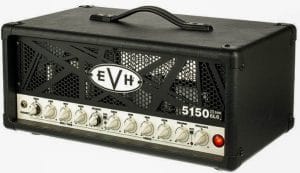
Get a 50-watt tube head and three channels
You get a 50-watt tube head and three channels on the 5150 model. It’s built to a high standard and has excellent tone for hard rock and metal guitar styles. You’ll need to purchase a good cabinet to go with this head. The three channels are clean, crunch, and lead.
Channel one and share the same EQ.
Channel 3 ha sits own separate EQ settings. You also get a global resonance and a presence control on it to further enhance the tone you get out of it. You’ll get vintage Van Halen tone out of it as well as modern tones for today’s metal playing.
It’s also great for rock, blues, and other styles of music, not just harder rock. Channel three really rips on the gain. The mao sounds good even at lower volumes, so you’ll get a lot out of it. You get an effects loop, and there is a footswitch. The head is lightweight at just35 pounds, so it’s easy to take with you to gigs. You get enough power for small clubs and bars with this head.
Design Specifications:
- Three channels
- 50 watts
- 7 x 12AX7 power tubes
- 2 x 6L6 preamp tubes
- 3-band EQ, Presence, Resonance
- Footswitch
- Effects loop
- 35 lbs.
- Headphones
- One input
- Speaker output
Pros
- Excellent build
- Greta gain sounds
- 3 channels
Cons
- Expensive
- Could use more watts
Whom is it Suited For?
It’s suited for anyone that wants to step up to regular practice amps and into cabinets or head territory. It sounds great for rock and metal playing, but it’s capable of playing many more styles at reduced gain settings. It’s the ideal solution for the intermediate or professional guitar player.
The EVH 5150 III 50W is an excellent amplifier for today’s guitar player. If you don’t want the Randall EOD88 try this model. It has three channels and superior gain for aggressive guitar styles. This is a clear winner and a recommended product.
To check the current price of EVH 5150 III 50W, click here
Randall EOD88 – high precision distortion with a lot of clarity and definition
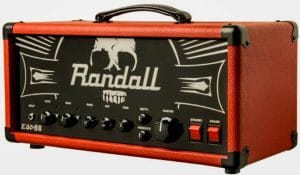
The Randall EOD88 is an 88-watt tube head.
It’s great for anyone that wants to go on stage as it has plenty of power. It has 12AX7 preamp tubes and KT88s for the power tubes. It sports a built-in fuzz circuit and also has three modes for the gain. You also get a footswitch to change the channel modes. The channel has EQ, Volume, and gain controls. The EQ settings include bass, middle, and treble controls, as well as presence and depth. This gives you enough control to shape the sounds that you want. It does not have a clean channel.
It’s perfect for old school metal playing from the late 790s and 80s. It has an effects loop so you can hook up your own pedals if you prefer. The gain channels produce everything from very light overdrive to full-on shred for heavy rhythm or screaming lead lines. There is a lot of variety through the three gain modes for the needs of almost any fan of classic heavy music.
Pros
- 3 gain channels
- Footswitch capable
- 88 watts
Cons
- No effects
- No clean channel
Specs:
- 88 watts
- 2AX7 preamp tubes and KT88s power tubes
- EQ: Volume, gain, presence, middle, bass, treble, depth
- I channel with three gain modes
- Footswitch capable
- Effects loop
- Dimensions 515mm x 235mm x 255mm
- Weight: 34.6 pounds
- Made in China
- Fuzz circuit
Whom is it Suited For?
It’s suited or those that need a lot of power for the stage. Pair this head with a good cabinet, and you’re all set. Setup your pedalboard for the effects, and it gives you all the gain that you need to play hard guitar styles. It’s good for intermediate and advanced guitar players. There is a bit too much power for beginners.
The Randall EOD88 is product designed for high-gain players. It has great classic distortion through the three gain channels. There is no clean channel, but that is not what it was designed for. It can handle classic metal and other styles with ease. If you need a good map for the stage, this one has you covered.
To check the current price of Randall EOD88, click here
BEST HEAVY METAL AMPS: BUYER’S GUIDE
Before purchasing a heavy metal guitar amp, you have several things that you need to consider. This handy guide should make it easier for you to get an excellent amplifier for whatever style you play.
Expect to Spend Some Cash
You won’t get a decent one without spending some money. Good quality products will cost you a lot of money. Expect to spend around $300-$1200 for a decent product. You will be disappointed if you buy at low cost. If you just plan to practice, a lower-cost one is ideal. For those that want a great tone or plan to gig, you’ll need to shell out some cash.
Distortion Matters
When looking at them you’re not going to be that concerned with the clean channel. Yes, you will use the clean channel at times for l, but most of the time, you’re going to be using distortion. If you want one that can crank out the distortion, you’re not going to be very satisfied with one that can just do a basic overdrive tone. You want one that has exceptional distortion. Don’t waste a lot of time and money on your selection if you have to hook it up to a bunch of pedals just to get a decent distorted tone out of it. This is why you need to focus on high-gain amplifiers. These products have the distortion that you want for playing heavy metal. This is especially the case for today’s heavy metal, where there is a ton of distortion.
Effects
There are a lot of amplifiers that come with effects. The problem with some of them is that the effects are not all that good. You should pay attention to the effects that come with your amplifier. It’s fine to get one that has a few effects, but you may want to use your own pedal-based effects as these tend to be better.
For example:
most digital delay effects that come with some of them probably won’t be all of that great. It’s a better option to get a pedal that produces digital delay than using a delay that is built into an amplifier. One of the effects that are usually pretty good with most of them is reverb.
Some of the effects, such as wah, wah, and tremolo, are usually not that great when they are built into one. You can get by with these effects might want to try pedal-based effects as they tend to be better. You can also get effects pedals that will produce a specific sound. For example, you can get pedals that will produce an industrial metal sound, death metal sound, classic metal sound, and so on. This can help you sculpt and refine your sound more.
Channels
Most of them tend to have two channels. When buying an amp for these styles of music, you’re more concerned with your distorted channel than with the clean channel. You should still have an amplifier that produces a good tone out of the clean channel, but your main focus will be on the distorted channel. You may also want to have an amplifier that has a footswitch. This makes it easy to change between the distorted tone and the clean tone. You’re going to want this if you play live all of the time
Tube Amps Vs. Solid State Amps for Playing Heavy Metal
You’ll find it at there are exceptional solid-state amplifiers as well as tubes for playing heavy metal. The thing to keep in mind is that tube amplifiers tend to produce a more natural tone. These are the classic amplifiers of old, and they are still relevant today because their tone is so sought-after. It doesn’t matter what type of music you are playing; you will find that a tube amplifier tends to be better.
Before you rush out and buy a tube amplifier, you should also know that solid-state has come a long way in recent years. In many cases, you will find that solid-state amplifiers sound just as good as tube amplifiers do. You may prefer the distortion that comes through solid-state amplifiers then you do with tubes. Of course, this is all just a preference. it is usually the individual amplifier and the tone that you prefer. You should not discount solid-state products for playing heavy metal music because you can get some excellent tones out of them.
Amp modeling
Another thing you should look at is amp modeling. These are essentially digital guitar products, and they recreate the sounds of amplifiers from the past. These are gaining in popularity because the circuits used to make them are now quite refined. Some of them produce really good distorted tones. One area where they shine is for recording and practicing. They are not as practical for large stages, but for other uses, they are really good choices.
What Are Preferable Guitar Amp Settings for Heavy Metal?
The settings that you put on your amplifier are all going to depend upon your individual needs. Many players simply crank everything up to 10 and expect a great tone. This usually is never the case. You may want screaming distortion, but in some cases, the dialing backed the Distortion a little bit will give you a better tone. Many of the most famous heavy metal songs were never produced with the Distortion at 10. By dialing back your Distortion, you can get a tone that is superior.
EQ settings
You should also play around with the EQ settings. For example, for heavy metal, you may want more bass for the rhythm sections. For the lead sections, you may want to turn up your treble or play around with the middle knob. It’s all trial and error, so you should work with whatever sound that you like. There are no real ideal settings for heavy metal because everyone has individual tastes.
The best thing you can do is to dial everything back to zero. Start turning up the knobs gradually and see how the tone sounds to you. Once you experiment a little bit, you should find a lot of tones that you enjoy. You may also find that affects such as chorus, delay, flanger, or a phaser effect add a lot of variety to your heavy metal tone.
FAQ FOR BEST HEAVY METAL AMPS
How Do I get a Good Metal Tone?
You need one that can produce a lot of distortion. The gain channel is the critical factor in a heavy metal amp. Make sure yours can produce a lot of gain that doesn’t sound muddy. You may also want some good effects that product distortion.
Can I use a Solid State Amp for Metal?
Yes, you can. There are good solid-state amps for metal. But in general, tubes tend to be a bit better as they have that warm sound that many players like. Use your ear and get what you prefer.
What Should I Spend?
A good one is going to cost you at least a few hundred dollars. Many products will cost into the thousands, but you want something that is going to sound good. If you spend too little, you’ll end up disappointed and will more than likely want to buy another amp.
My Amp Make Noises, what is Wrong?
In many cases you will have a bad tube if has tubes. If your solid-state amp is making noise, it’s possible something is loose inside. It’s best to have it serviced. You may void your warranty if you open it yourself.
How Many Watts Do I Need?
You need around 10-12 for practice. 30-50 is fine for larger gigs. 50 and up will be ideal for larger stages. For arenas or other large areas 100 watts is a must. You can, of course, buy a large watt amp and then just turn it down to an acceptable level if that is what you prefer.
What is an Effects Loop?
The loop allows you to attach pedals to your amp. This gives you more versatility with your sound. Most expensive ones have an effects loop. Some amps have poor effects or not many effects at all, so pedals are often used to beef up the sound.
CONCLUSION
These amps are the best for playing heavy metal music. Consider the Fender Champion 40 as it’s the best heavy metal amp on out list. All of the other products are also excellent options. Look for one that gas good distortion, which is what you want for metal. Tubes are ideal, but you can get some decent solid state ones as well. You’ll find great products amp out there for aggressive style of music, so have fun shredding.
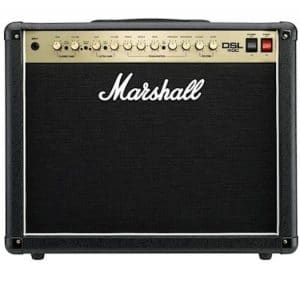

[…] Heavy Metal Amps […]